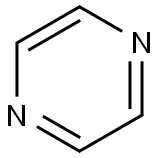Chemical Properties
Pyrazine has a strong pyridine-like odor. Some reports compare the taste of pyrazine to cooked spinach or rancid peanuts
Chemical Properties
white crystals or powder
Occurrence
Pyrazine has been detected in several food products including papayas, asparagus, peanuts, popcorn, soybeans, corn, French fries, bread, cheese, milk, eggs (boiled), chicken (fried), beef (cooked), shrimp, clams, beer, sherry, malt, coffee and tea (green).
Uses
Pyrazine is used as a flavoring agent. It serves as a component of some herbs in traditional Chinese medicine. It is employed as pharmaceutical intermediates, perfume intermediates and involved in the preparation of other chemicals. In addition to this, it is used in the production of pyrazine 1-oxide.
Definition
A heterocyclic aromatic compound with a six-membered ring containing four carbon atoms and two nitrogen
atoms.
Definition
ChEBI: A diazine that is benzene in which the carbon atoms at positions 1 and 4 have been replaced by nitrogen atoms.
Definition
pyrazine: An unsaturated heterocycliccompound having two nitrogenatoms in a six-membered ring,C4H4N2; r.d. 1.03; m.p. 52°C; b.p.115°C. Pyrazine is a symmetric diazine.
Preparation
Prepared by cyclization of α-amino ketones, which were produced by the reduction of isonitroso ketones to yield the dihydropyrazines, which are dehydrogenated with mercury(I) oxide or copper(II) sulfate or sometimes with atmospheric oxygen.
Aroma threshold values
300 ppm (odor threshold in water)
General Description
Pyrazine is a 1,4-diazine and an electron-deficient N-heteroarene found in several natural products, APIs, agrochemicals, and functional materials.
Purification Methods
Distil pyrazine in steam and crystallise it from water. Purify also by zone melting. [Beilstein 23 H 91, 23 II 80, 23 III/IV 899, 23/5 V 351.]
